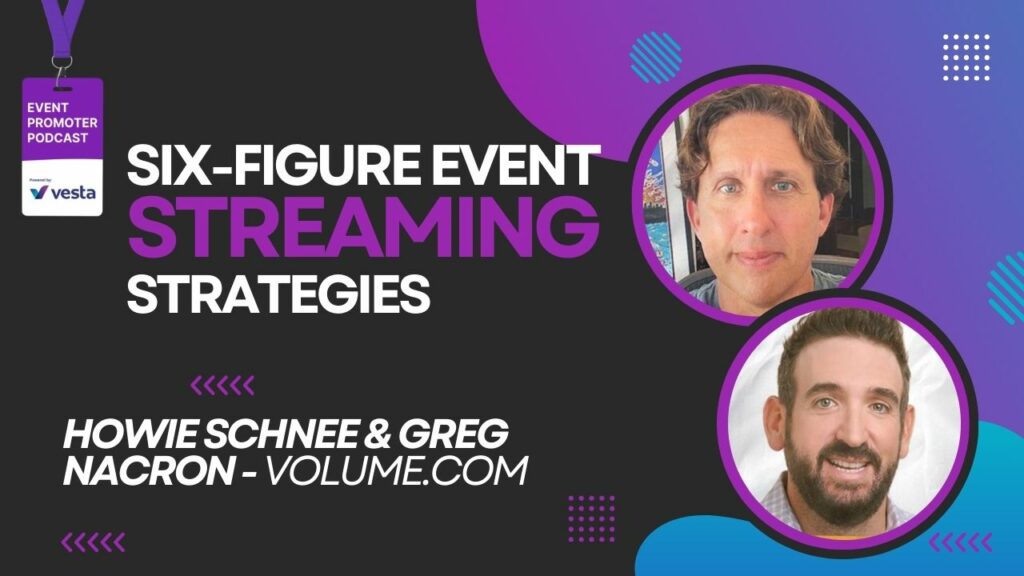Watch on YouTube | Listen on Spotify | Listen on Apple Podcasts
Can event live streaming generate an event organizer meaningful revenue?
In one of our most popular blog posts, we compiled the top ways music venues can generate revenue beyond ticket sales. This is generally applicable to anyone that has their own event space looking to be more sustainable with their revenue sources.
One of those ways is through live streaming.
I’ll admit, as an event organizer myself, I have long believed that live streams hurt ticket sales. Recently, however, multiple venue organizers and musician friends have told me that’s not the case anymore. Maybe it never was the case.
Volume.com is a live streaming platform and community for the music industry. They aim to provide an equitable way for musicians of all sizes to connect more directly with their fans even when they can’t do that in-person at shows.
Greg Nacron, COO at Volume, says “There is never a person who wants to go to a show and doesn’t go because of a live stream. It’s not the same experience. The live streams are nothing but FOMO. So people who go to them are people who literally cannot go to a show geographically. They’ve got things to do that they can’t go, but they’re invested.”
These insight challenges a long-held belief in the industry and opens up new revenue opportunities for event organizers.
Leveraging live streaming allows venues and artists to tap into a broader audience, including those who cannot attend in person. Alessia Priolo also made this point last year when we interviewed her about the experience of successfully producing and promoting a metaverse music concert showcase.
Virtual versions of an event expand reach and not only increases fan engagement but also provides additional revenue streams through ticket sales, subscriptions, and merchandise.
In this blog post, we will explore how live streaming can become a vital component of your event promotion strategy. We’ll dive deeper into the practical ways it can generate meaningful revenue, enhance fan relationships, and provide valuable data to inform your marketing efforts. We’ll also highlight key takeaways from our recent podcast episode with Howie Schnee and Greg Nacron from Volume.com, offering a comprehensive look at the future of event promotion in the digital age.
Six-figure Event Live Streaming Strategies with Volume.com | Event Promoter Podcast Full Video
The Myth Debunked: Live Streaming Doesn’t Cannibalize Ticket Sales
For years, event organizers have been hesitant to embrace live streaming, fearing that it would lead to a decrease in ticket sales. The assumption was that if people could watch an event from the comfort of their homes, they would be less likely to attend in person. However, this myth has been debunked by industry experts and real-world examples.
Understanding the FOMO Factor
One of the key reasons why live streaming doesn’t cannibalize ticket sales is the fear of missing out (FOMO) factor.
When an event is live-streamed, it creates a sense of urgency and excitement among fans who cannot attend in person.
They feel compelled to tune in and be a part of the experience, even if it’s through a screen. This FOMO effect can actually drive ticket sales, as fans who enjoy the live stream may be more likely to attend future events in person.
Tapping into Geographically Diverse Audiences
Live streaming allows event organizers to reach audiences that may not have been able to attend due to geographical constraints.
Making the event accessible to a wider audience allows organizers to expand their fan base and create new opportunities for revenue.
This is particularly valuable for niche events or those with a dedicated following spread across different regions. Live streaming enables these fans to engage with the event and support the artists or organizers, regardless of their location.
Engaging Fans Unable to Attend in Person
There will always be fans who cannot attend an event in person due to various reasons, such as scheduling conflicts, financial constraints, or health concerns. Alessia Priolo stressed that event live steams is a form of accessibility in our podcast with her talking about metaverse concerts.
Live streaming provides an alternative way for these fans to participate and feel connected to the event. By offering a virtual ticket option, event organizers can cater to this audience and generate additional revenue without compromising the in-person experience. This inclusive approach helps build loyalty and strengthens the relationship between fans and the event brand.
Industry experts, like Howie Schnee and Greg Nacron from Volume.com, have witnessed firsthand how live streaming complements rather than competes with in-person events.
Embracing this technology and understanding its potential means event organizers can now tap into new markets, engage a wider audience, and create a sustainable revenue stream that enhances rather than detracts from the traditional event model.
Building a Sustainable Revenue Stream with Live Streaming
Live streaming opens up a world of possibilities for event organizers to generate revenue beyond traditional ticket sales. Strategic ticketing, subscription models, merchandise sales, and sponsorship opportunities create a sustainable revenue stream that complements in-person events.
Ticketing Strategies for Virtual Events
Virtual events can be monetized through ticket sales, just like in-person events.
Event organizers should offer different ticket tiers, such as general admission, VIP access, or exclusive behind-the-scenes content.
Tiered pricing gives fans the flexibility to choose the experience that best suits their interests and budget while allowing organizers to maximize revenue. Early bird discounts and limited-time offers create a sense of urgency and encourage fans to purchase tickets promptly.
Subscription Models: Cultivating a Dedicated Fan Base
In our podcast interview, the Volume team alludes to some creators on the platform that have turned subscriptions into a six-figure revenue stream for them.
Event organizers and creators can cultivate a dedicated fan base willing to pay a regular fee by providing access to exclusive content, such as monthly live streams, Q&A sessions, or intimate performances.
This model is particularly effective for artists or venues with a strong, loyal following. Platforms like Volume.com simplify the process of setting up and managing subscription-based live streams, ensuring a seamless experience for both creators and fans.
Merchandise Sales and Virtual Merch Tables
Live streaming events are an excellent opportunity to showcase and sell merchandise to a captive audience. Virtual merch tables, set up alongside the live stream, allow fans to purchase items without leaving the viewing experience.
Organizers should offer event-specific merchandise, such as limited-edition t-shirts, posters, or digital downloads, to create a sense of exclusivity and encourage sales.
Integrating merchandise sales into the live streaming platform streamlines the purchasing process and makes it easier for fans to support their favorite artists or events.
Sponsorship Opportunities in the Digital Space
Sponsorships, a significant source of revenue for in-person events, also apply to live-streamed events. The digital space presents unique sponsorship opportunities, such as branded overlays, video ads, or sponsored segments during the live stream.
Organizers should partner with brands that align with their event’s theme or target audience to provide exposure to a highly engaged viewership. Sponsored giveaways or exclusive offers can also be incorporated into the live stream, encouraging fan interaction and generating leads for sponsors.
Diversifying revenue streams through ticketing, subscriptions, merchandise sales, and sponsorships creates a sustainable financial model for live-streamed events. This approach mitigates the risks associated with relying solely on in-person ticket sales and provides fans with more ways to support and engage with the events they love.
Enhancing Fan Relationships through Live Streaming
Live streaming offers event organizers a unique opportunity to strengthen fan relationships and create a deeper connection with their audience. By providing exclusive content, fostering interactive experiences, and creating a sense of community, organizers can cultivate a loyal and engaged fan base that extends beyond the boundaries of physical events.
Providing Exclusive Content and Behind-the-Scenes Access
Exclusive content and behind-the-scenes access give fans a reason to tune in and feel more connected to the event and the performers. Organizers can offer backstage interviews, rehearsal footage, or special performances that are only available through the live stream. This exclusive content creates a sense of intimacy and makes fans feel like they are part of the inner circle. By providing a glimpse into the world behind the curtain, organizers can deepen the bond between fans and the event, encouraging long-term loyalty and support.
Fostering Interactive Experiences with Q&A Sessions and Live Chats
Interactive experiences, such as Q&A sessions and live chats, transform live streaming from a passive viewing experience into an engaging, two-way conversation. Organizers can host real-time Q&A sessions with artists, speakers, or industry experts, allowing fans to ask questions and receive immediate responses. Live chats enable fans to interact with each other and with the event organizers, creating a sense of camaraderie and shared experience. By fostering these interactive elements, organizers can make fans feel heard, valued, and more invested in the event.
Creating a Sense of Community among Virtual Attendees
Live streaming has the power to bring fans together, regardless of their physical location. Organizers can create a sense of community among virtual attendees by encouraging interaction, hosting virtual meet-ups, and creating shared experiences. For example, organizers can set up virtual breakout rooms where attendees can network and discuss the event or incorporate interactive polls and surveys that allow fans to share their opinions and feel like they are part of the conversation. By fostering a sense of belonging and connection, organizers can build a loyal community of fans who will continue to support and engage with the event long after the live stream has ended.
Enhancing fan relationships through live streaming requires a thoughtful and strategic approach. By providing exclusive content, fostering interactive experiences, and creating a sense of community, event organizers can deepen the bond between fans and the event, leading to increased loyalty, engagement, and long-term success.
Data-Driven Insights: Leveraging Live Streaming Analytics
Live streaming provides event organizers with a wealth of valuable data that can be used to make informed decisions, refine strategies, and improve future events. By identifying core audiences, tracking engagement metrics, and leveraging data to inform planning and marketing efforts, organizers can optimize their live streaming approach and achieve better results.
Identifying Your Core Audience and Their Geographical Distribution
Live streaming analytics allow event organizers to gain a deep understanding of their core audience and their geographical distribution. By analyzing viewership data, organizers can determine which regions or countries have the highest concentration of fans and tailor their content and marketing strategies accordingly. This information can also help organizers identify potential markets for future growth and expansion. Understanding the geographical distribution of the audience can inform decisions about event timing, language offerings, and localized content, ensuring that the live stream reaches and resonates with the target audience.
Tracking Engagement Metrics to Refine Your Streaming Strategy
Engagement metrics, such as viewing duration, chat activity, and interaction rates, provide valuable insights into how the audience is responding to the live stream. By tracking these metrics, event organizers can identify which segments of the stream are most engaging and which may need improvement. For example, if viewership drops significantly during a particular segment, organizers can analyze the content and make adjustments to keep the audience engaged. Similarly, if certain types of interactive elements, such as polls or Q&A sessions, generate high levels of participation, organizers can incorporate more of these features into future streams to enhance the viewer experience.
Using Data to Inform Future Event Planning and Marketing Efforts
Live streaming analytics can provide a rich source of data to inform future event planning and marketing efforts. By analyzing viewership trends, audience demographics, and engagement patterns, organizers can make data-driven decisions about programming, content, and promotion. For example, if data shows that a particular artist or speaker consistently attracts a large audience, organizers can prioritize booking them for future events. Similarly, if data reveals that a specific marketing channel, such as social media or email campaigns, is particularly effective at driving viewership, organizers can allocate more resources to those channels to maximize their reach and impact.
Data-driven insights are essential for event organizers looking to optimize their live streaming approach and achieve long-term success. By identifying core audiences, tracking engagement metrics, and leveraging data to inform planning and marketing efforts, organizers can make informed decisions that enhance the viewer experience, increase engagement, and drive better results.
Key Takeaways from the Podcast with Howie Schnee and Greg Nacron
The insights shared by Howie Schnee and Greg Nacron from Volume.com in our recent podcast episode shed light on the evolving role of live streaming in the event industry. Their experiences and success stories demonstrate the importance of adapting to the changing landscape and embracing new strategies for growth.
Redefining the Relationship between Live Streaming and In-Person Events
One of the key takeaways from the podcast is the need to redefine the relationship between live streaming and in-person events. Rather than viewing live streaming as a threat to ticket sales, event organizers should recognize its potential to complement and enhance the overall event experience. By offering virtual tickets and exclusive online content, organizers can expand their reach, engage a wider audience, and create additional revenue streams without cannibalizing in-person attendance.
Utilizing Live Streaming as a Powerful Fan Engagement Tool
Event live streaming is not just about broadcasting an event; it’s also a powerful tool for fan engagement. Howie and Greg emphasize the importance of creating interactive experiences, such as Q&A sessions, live chats, and behind-the-scenes access, to foster a sense of connection and community among virtual attendees. By prioritizing fan engagement, event organizers can build stronger relationships with their audience and cultivate a loyal fan base that extends beyond the boundaries of physical events.
Embracing Data-Driven Strategies for Sustainable Growth
Another key takeaway from the podcast is the significance of embracing data-driven strategies for sustainable growth. Live streaming analytics provide valuable insights into audience demographics, geographical distribution, and engagement patterns. By leveraging this data to inform event planning, content creation, and marketing efforts, organizers can make informed decisions that optimize their live streaming approach and drive better results. Howie and Greg’s experiences underscore the importance of using data to adapt, refine, and grow in an ever-evolving industry.
You can catch the full episode on our YouTube channel or your favorite podcast platform.
Check out some of our other podcasts and resources for event promoters below.




